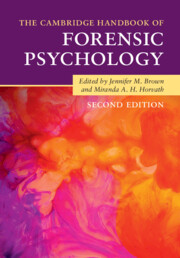Book contents
- The Cambridge Handbook of Forensic Psychology
- The Cambridge Handbook of Forensic Psychology
- Copyright page
- Dedication
- Contents
- Figures
- Tables
- Contributors
- Preface
- Forensic Psychology
- Part I Psychological Underpinnings
- Part II Psychology and Criminal Behaviour
- Part III Assessment
- 3.1 Credibility and Investigative Interviewing
- 3.2 Eyewitness Testimony
- 3.3 Psychopathic Personality Disorder
- 3.4 Forensic Mental Health Assessments
- 3.5 Intellectual Disabilities and Offending Behaviour
- 3.6 Head Injury and Offending
- 3.7 Parole Decision-Making
- 3.8 Risk and Dangerousness in Adults
- Part IV Interventions
- Part V Civil Proceedings
- Part VI Professional Practices
- Index
- References
3.3 - Psychopathic Personality Disorder
from Part III - Assessment
Published online by Cambridge University Press: 02 December 2021
- The Cambridge Handbook of Forensic Psychology
- The Cambridge Handbook of Forensic Psychology
- Copyright page
- Dedication
- Contents
- Figures
- Tables
- Contributors
- Preface
- Forensic Psychology
- Part I Psychological Underpinnings
- Part II Psychology and Criminal Behaviour
- Part III Assessment
- 3.1 Credibility and Investigative Interviewing
- 3.2 Eyewitness Testimony
- 3.3 Psychopathic Personality Disorder
- 3.4 Forensic Mental Health Assessments
- 3.5 Intellectual Disabilities and Offending Behaviour
- 3.6 Head Injury and Offending
- 3.7 Parole Decision-Making
- 3.8 Risk and Dangerousness in Adults
- Part IV Interventions
- Part V Civil Proceedings
- Part VI Professional Practices
- Index
- References
Summary
Psychopathic Personality Disorder (PPD) plays a central role in forensic clinical practice. It has relevance for violence risk and treatment responsivity; those suffering from it place financial and other burdens on services. PPD remains a controverted concept; the essence of the disorder remains disputed. In this chapter I examine the history of the concept, methods for its evaluation, its demography and its relevance to clinical practice—from the first interview, through risk formulation to intervention. I describe recent attempts to explicate the concept of the PPD, including the development of the Comprehensive Assessment of Psychopathic Personality (CAPP). I conclude by considering current controversies regarding the diagnostic significance of criminal behaviour, the predictive utility of historical instruments such as the Psychopathy Checklist Revised and the reliability of that instrument in forensic clinical practice.
Keywords
- Type
- Chapter
- Information
- The Cambridge Handbook of Forensic Psychology , pp. 369 - 387Publisher: Cambridge University PressPrint publication year: 2021



